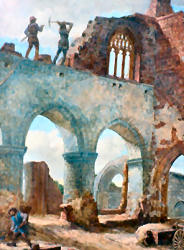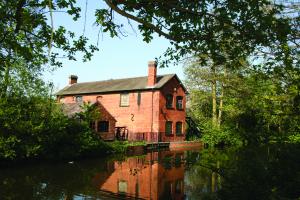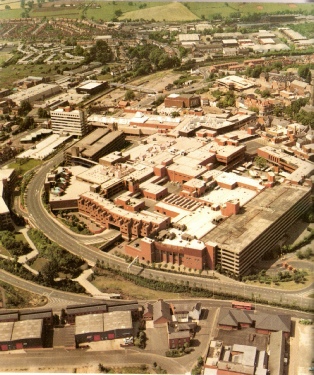Before the 12th century, Redditch did not really exist. The area being on the fringes of Feckenham Forest and the river Arrow meandered through its flood plain with wooded, marshy areas on its banks whilst Tardebigge was the nearest community of any note.
It was to this area that a party of 12 monks came from Garendon in Leicestershire to found a daughter abbey. The were granted land by Waleran de Beaumont, Earl of Worcester in the area known as Bordesley. These were Cistercian white monks, an order that had broken away from the Benedictine order to return to the simpler was originally laid down by St Benedict. These were skilled artesians, water engineers and the waterlogged site was ideal for their purpose.
They cleared trees from the area and used the timber to build their first wooden abbey. The set about diverting the course of the river Arrow cutting off the marshy area from its source of water and so draining the area. They established fish ponds to provide food and constructed water driven iron forges to shape the tools the needed and supply surround areas.
Gradually as the area drained they constructed a pebble raft as foundation for the stone build abbey complex. This followed traditional designs with not only accommodation for the brothers to live and worship but for visitors in a nearby hospital complex Soon an community grew up around the abbey gates and a second place of worship, St. Stephens Chapel was build aside the gate.
A network of farms or granges was established providing income from rents and sheep farming and grew to the eighth wealthiest Abbeys in the country. Some tome in this period it is rumored that Batchley Brook which ran down from Tardebigge, south of the Abbey site to the Arrow picked up a reddish tint from the iron content of the clay soil and so was often called the red ditch. Soon the name stuck and Redditch at last got a name.
But life in the Abbey was never easy, subsidence and collapse necessitated constant rebuilding whilst plague visit the area at least twice causing the number of brothers to fall back down to around twenty. They lost the iron mils to fire and floods and the importance of the Abbey declined.
The final blow of course came as a result of Henry VIII's dispute with Rome when his dissolved the monasteries and pensioned of their inhabitants. Soon the Abbey was razed to the ground, the stone being robbed out for local building and the wood & lead from the roof to support wars overseas.
The community around the gatehouse struggled on for many years but gradually the moved away to higher ground about a mile south of the site. In 1803 the local residents petitioned Parliament and authority was given to build a new church in the centre of the new community. St. Stephens gatehouse chapel was now plundered for stone for the new building which, in 1805, was rebuild again with public subscription to what we see today in Church Green.
In the 18th and 19th centuries through a combination of factors needle making began to flourish in the villages south of Redditch. The arrow provided power to many water driven mills and gradually these converted from grain and iron working to the more lucrative process of needle scouring. By the end of the 1800's needle making had consolidated in the town of Redditch and some 95% of the worlds consumption of needle originated from the area. Soon the needle makers diversified into fish hooks, fishing tack and springs an notions, engineered metal products of all kinds. Redditch was now an industrial town and cycle, motor cycle, battery manufacture grew alongside the established light engineering.
World war two saw another development with not only local established firms turning over production to support the war effort but new armament, gun and aircraft component factories cam to the area with a corresponding influx of skilled workers.
Sadly the immediate post war boom turned into a slow decline in the late fifties and early sixties and there was a risk of Redditch going into another period of decline. Here fate took a hand once again and in 1964, after years of debate, an order was signed designating Redditch a “New Town”. So the next twenty years saw an unparalleled programme on investment, building and promotion of the area with the Development Corporation delicately balancing new jobs to housing.
The Development Corporation, sometimes to the dismay of local residents, set about their task to quadruple the size of the town. Luckily they resisted the temptation of the time to build upwards and Redditch was spared the ill-fated tower blocks so many town endured in the 1960's.
They also sympathetically built the new housing estates maintaining natural features where possible and a road system that is still the envy of many fifty years later. However, in Hindsight, the corporation did not get every decision right and the “bead” local community centres in Woodrow, Church Hill, Winyates and Walkwood have not stood the test of time.
Perhaps the most controversial decision that had to face was the siting of the town centre. They had two options, redevelop the existing town centre or build a new one on a new site. Either option was bad news for the existing town centre and in hindsight the redevelopment of the existing town centre was the lesser of the two evils. A new town centre would have meant the slow decline of areas such as Evesham Street and little incentive to redevelop surround streets. These streets were dated and in decline and would have been lost in due course anyway. So the redevelopment of the Evesham Street and the surrounding area ensured that adjacent areas such as Church Green and Market place survived. Only the redevelopment of Alcester Street has proved to be a mistake where we now have characterless modern buildings where modernized old ones would have better suited the town.
As we move past the 50th anniversary of the designation of Redditch as a new town does the need to ensure Redditch Town Centre is more than an enclosed Mall rise higher on the councils agenda. The beauty of Church Green on a warm sunny day needs to be extrapolated to an inviting community & family friendly area in the evenings. This is the next challenge for a town that has had to adapt and change as the needs of its residents change.

St. Stephen's Gate House Chapel.
Image from Forge Mill Needle Museum
Image from Forge Mill Needle Museum

The demolition of Bordesley Abbey,
Image from Forge Mill Needle Museum
Image from Forge Mill Needle Museum

Forge Mill across the mill pond.
Image from Forge Mill Needle Museum
Image from Forge Mill Needle Museum

Redditch New Town Town Centre
Image from Redditch Local History Museum
Image from Redditch Local History Museum